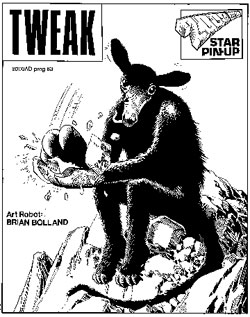The central United States is a hotbed for monstrosity—or at least it’s been that way since the Atomic Wars of 2070. As related in the Judge Dredd stories of 2000 AD, that’s when nuclear fire storms ravaged America’s “flyover states” and left it a radiated no man’s land.
As such, more refined denizens of the 22nd century tend to steer clear of the Cursed Earth and its many mutants, cannibals, genetically-resurrected dinosaurs and killer robots. But every now and then, you do find some decent folk out there—and even a decent monster on rare occasion.
Meet Tweak, an extraterrestrial being whose luck went from bad to worse when he was kidnapped from his native planet as a zoological specimen, then sold to Cursed Earth slavers. He might not look out of place next to most terrestrial animals, but his species is about as alien as they come.
Despite his rather beastly appearance, Tweak’s species boast a technologically advanced culture and limited psychic abilities. They live in vast subterranean cities and mine their food source directly from the planet’s crust—in the form of rocks and minerals. That’s where those powerful, oversized claws come into play: for crunching down granite and quartz into bite-size gravel.
How does Earth life match up to that? We certainly have “mineral-crunching” bacteria that love stone soup (hold the broth) as well as old Tweak here. But as far as creatures of comparable size go, he really has no equal.
When Earth animals munch down rocks and minerals, they tend to fall into one of two categories:
Dirt Eaters: Or, to put things a little fancier, we’re talking about geophagy or pica—the animal consumption of dirt and minerals. It’s exceedingly wide spread and enables animals (humans included) to take in necessary nutrients. Deer, for instance, eat calcium and magnesium-rich soil during antler growth. But there’s an even more compelling reason for dirt dinner: to detoxify plant products. See, bad tastes and poisons are the vegetable kingdom’s way of bossing us around. “Eat us WHERE and WHEN we tell you to,” say the plants. And since we tend to avoid maddening rashes and disastrous diarrhea when we can help it, we do what they say. Ah, but what if we much down some minerals to bind the toxins in that poisonous meal? Parrots do it. Countless other animals do it, including very cultured humans who turn to anti-diarrhea medications containing palygorskite, which is found in clay. UIC Chicago has a nice, detailed presentation on pica here.
Stone Eaters: Other terrestrial organisms go a a little bigger on their dirt snacks, gobbling down pebbles or rocks known as gastroliths or gizzard stones. The dinosaurs did it. Many species of birds and reptiles do it. A few seals and whales even get in on the action. What’s it all about? Well, birds store the jagged rocks inside their gizzard to grind down their food (which they swallow whole). As this University of California Museum of Paleontology article discusses, we’re less sure on the reasons when it comes to aquatic animals such as whales and crocodiles. We used to think it had to do with buoyancy, but studies now show that many aquatic animals don’t carry enough stones to make a difference. Likewise, some plant-eating dinosaurs didn’t pack enough stones to effectively grind their food—so the mystery remains.
Just rest assured that dinosaurs didn’t feast on gold, granite and diamonds like our friend Tweak.
Want to read all about the little guy? You’ll find his story in the excellent Cursed Earth saga, collected in Judge Dredd: The Complete Case Files 02. And on the subject of geophagy, this article by Jared M. Diamond is also helpful.
Monster of the Week is a — you guessed it — regular look at the denizens of our monster-haunted world. In some of these, we’ll look at the possible science behind a creature of myth, movie or legend. Other times, we”ll just wax philosophic about the monster’s underlying meaning. After all, the word “monstrosity” originates from the Latin monstrare, which meant to show or illustrate a point.
Image credit: © 2000 AD and Rebellion A/S. Art by Brian Bolland
Originally Published at HSW: Monster of the Week: Tweak (2000 AD)
Robert Lamb is a senior writer at HowStuffWorks.com and co-host of the Stuff to Blow Your Mind podcast and blog. He is also a regular contributor to Discovery News. Follow him on Twitter, Facebook or Tumblr. If you’re into that sort of thing.










